#amazon multi channel fulfillment
Explore tagged Tumblr posts
Text
Buy Walmart Seller Account For Any Country
Buy Walmart Seller Account
Buy Walmart Seller Account – 100% Safe & Best Marketplace
Buy a Walmart Seller Account to start your E-Commerce business. Connect to CRM, Summary, People, Signals & News. About. Buy Walmart Seller Account.

Our service gives:-
✅ 24/7 Customer Support
✅ 100% Satisfaction & Recovery Guaranteed
✅ Email Login Access
✅ Bank Added
✅ Card Verified
✅SNN code and Router number.
✅ Phone Access
✅ Driving License Scan Copy
✅ Date of Birth Provided
✅ First Delivery
✅ Realistic Photo Attached Accounts
✅ Complete Account Access
✅ Account from unique IPs
✅Personal and Business accounts.
✅100% phone verified USA, UK, and other countries.
✅100% Full document verified.
To Talk More About Getting & Buy Any Service Contract With Us:
24 Hours Reply/Contact
Email: [email protected]
WhatsApp: +1 803-216-5479
Telegram: @smmeshops
Skype: [email protected]
The History Of Walmart Marketplace
Considering the eventuality of online businesses, Walmart launchedwalmart.com in the year 2000. The website was designed to offer a
flawless and harmonious client experience – be it store or online.
In 2007, it launched its Store Service, where it innovated the concept of multichannel shopping by allowing guests to pick their online orders in stores.
During 2009, Walmart stepped into the online world and created the so- called Walmart Marketplace. The idea was to invite different third- party merchandisers
and help them find their products atWalmart.com.
Ultimately, this conception opened a whole new avenue and brought in colorful retailers countrywide, growing their openings to a more significant position.
At the moment, it boasts more than 300- 400 retailers, including some big titans like eBags, ProTeam, and Wayfair. The products of third- party merchandisers are vended
together with the name “ Walmart Marketplace ” on the Walmart force( online). This is substantially to distinguish them from the usual particulars.
The particulars that are vended from a third party aren't traded or vended in stores.
In August 2016, WalmartInc. acquired thee-commerce businessJet.comInc. for 3 billion USD. This makes it a big deal for merchandisers because their
products can be stressed onWalmart.com elevations. Also, its massive consumer followership is another advantage.

Should Walmart Be A Part Of Your Multi-Channel Strategy?
Since Walmart is decreasingly inclining its growth every time, it's great news for all business merchandisers out there. After all, the idea is to invite implicit
shoppers and offer competitive advantages to merchandisers.
Doug McMillon, Walmart CEO, has stated that their 2- day free shipping concept has formerly given “ an amazing supplement ” in terms of deals. So, this makes
It is a great time to talk about multichannel selling. Still, this might not be as easy as it sounds.
The further channels and SKUs you manage, the more advanced are the possibilities to lose track of your force and orders. still, you could go with intelligent robotization
tools to help you with that.
What is Walmart Marketplace?
Walmart Marketplace is an online platform, like Amazon and eBay, where small businesses can list their products for trade online, alongside Walmart’s own products.
Walmart has long distinguished itself for its low prices, so this business is a good fit for merchandisers that offer great products at affordable rates.
You can use Walmart’s Sponsored Hunt advertisements to promote your products to Walmart’s callers and use their fulfillment services, if asked ,
to handle the logistics of managing force and shipping out orders.
How much is your Walmart Marketplace seller account worth?
We reached out to the investor that purchases these accounts and asked them about the process. The accounts are valued grounded on age,
deals history and number of dealer reviews. Newer accounts that have little to no deals history or dealer reviews are generally worth a many hundred bones and
aged accounts with good deals history and a considerable quantum of dealer reviews can be worth many thousand bones .
Is it safe to sell my Walmart Marketplace seller account?
According to the investor, it's 100% safe and secure to sell your account. After they confirm that your dealer account is licit and in good standing,
payment is transferred to the dealer. also they give you with new company and fiscal information for you to remove yours and replace with the new word so that
none of your sensitive information remains. Once you have completed the process, you give access to the account, icing that your sensitive information is norway
seen or remains after the transfer.
How do you get an offer to find out how much your account is worth?
We ’ve included a link below to an online form where you'll enter some information about your account. It generally takes about 5 twinkles to complete and
after you submit your word, you're transferred an offer for your account within 1 business day.However, the payment and transfer process generally takes about
1- 3 business days to complete, If you choose to accept the offer.
How to Set up a Seller Account on Walmart Marketplace
Walmart is one of the largest retailers in the world. Walmart is gaining its position as a US eCommerce point via retail, websites, and mobile apps.
As Walmart continues to make out its business capabilities, the number of approved merchandisers has been climbing at an adding pace. This business has been
historically conservative about who they allow dealing on their platform. Their delicate operation process and strict conditions have been a roadblock for
numerous-commerce merchandisers. In this moment's blog, we will show you how to set up a dealer account on Walmart.
New seller incentives

Because Walmart Marketplace is presently in a growth phase, it’s a boon for merchandisers at the moment. Walmart has offered a range of promos for brands
willing to subscribe up. While these can shift over time, one of the most recent promos Walmart offered was a 25 reduction in commission rates for the first
90 days of selling.
Economies of scale
For merchandisers who are formerly using business tools like warehousing and fulfillment coffers, integrating into the Walmart ecosystem can be fast and easy.
While costs might rise due to increased use, you ’re effectively spreading your investment across further than one occasion. This drives raised profit without a
commensurable increase in spending.
Omni-channel opportunities
By adding Walmart Marketplace to the blend of being platforms you use, you ’ll have the occasion to take an omni- channel approach by spreading your products and
services across Walmart’s online and physical stores. With different requests and deals strategies, the Walmart Marketplace gives you another followership to engage with.
Expert tips for selling on Walmart Marketplace
numerous brands have their reasons for using this platform and can establish themselves on Walmart’s business, but not all guests will be made equal.
Some merchandisers will perform better than others, so, if you want to be the stylish of the stylish and come a name shoppers come to know and trust, keep these expert
tips in mind.
Win the Buy Box
Buy Box products are the first and largest result on hunt runners; all other products are listed below. The Walmart algorithm uses a many crucial criteria
to weigh who'll win the most affordable pricing, including shipping costs, force situations, and accurate information about product quality.
Still, your products are in stock, and your rosters are accurate, If your pricing is competitive.
Have competitive pricing
As compelling as it might be to keep your prices high for maximum profit, this is n’t a stylish marketing strategy. rather, you need to keep pricing in line
with client prospects. This frequently means changing the right balance between remaining competitive while still doing as much as possible to turn a profit.
Managing this successfully may bear price testing, in which pricing is acclimated and estimated against deals. This, alongside force vacuity and contender geste ,
can help you come to a price that will win the Buy Box.

Understand your audience
Some brands assume the buyers on Walmart will be the same as those on platforms like Amazon and Target, but this is n’t inescapably the case.
The demographics can be different, particularly concerning youngish shoppers who might protect in person at Walmart, buy online at Amazon.
By understanding who's shopping on Walmart’s website for products like yours, you can tweak product descriptions, optimize keyword use,
and place flings strategically to capture the most effective guests for your brand.
Use automation
Doing everything yourself, from curating product information to client exploration to assaying the competition, is theoretically possible,
but can eat up a significant quantum of time with minimum substantiation that you ’re getting anywhere. Through the use of Walmart advertising software,
you can let robotization take over the hard corridor. Streamline workflows, access thorough yet stoner-friendly analytics,
and produce juggernauts that target all areas of the deals channel.
robotization can also help with placing flings on keywords for PPC announcement juggernauts. Platforms like ours influence your objects,
to run tests by changing flings, and establishing optimal settings. robotization on larger product registers can be a good way to get ahead without a
significant time investment.
Keyword harvesting
It’s hard to succeed in PPC advertising if you ’re not using the right keyword approach. Rather than trying to keep up with clicks, transformations,
and prints for everything you have listed for trade, automating this process can help you gather the stylish possible keywords for your products.
With the right AI- guided tools, you can manage your juggernauts while letting advertising software shoulder the burden of bidding and data analysis.
In summary
Dealing on Walmart Marketplace can feel dispiriting at first, after all, adding another eCommerce platform to the blend requires considerable time investment,
but getting started, particularly if you formerly have a presence on spots like Amazon, can be easier than you suppose.
And, if you ’re formerly using or are considering employing an eCommerce tool designed to automate and streamline pricing, keyword use, bidding, and followership analysis,
creating a robust and profitable storefront can be a great occasion to turn a profit. Contact Trellis moment to see what our moxie and AI results can do to
move your business forward.
How much does it cost to sell on Walmart Marketplace?
There are no outspoken costs involved with dealing via the Walmart business. Unlike platforms that charge class or subscription freights, getting started is free.
Rather, Walmart charges commissions on deals grounded on order, ranging from around 6 to 20. There also may be new stoner promos that can reduce the overall cost for
the first many months.
How long does it take to start selling on Walmart?
Assuming all account details are handled duly and there’s no need for fresh information, it can take between two to four weeks for Walmart’s
internal platoon to review and authorize your account. To minimize detainments, respond to any queries the Walmart platoon has as snappily as possible to insure
a prompt launch to selling.
Can individuals sell on Walmart Marketplace?
Yes, individualities can be sold on Walmart Marketplace. Still, a social security number is not permitted as a way to produce and corroborate an account. therefore,

If an individual dealer wants to begin listing products, they ’ll need to produce some kind of business that uses a drum. An LLC is a simple way for single merchandisers
to produce a company- such as structure.
Note that Walmart generally should not be the first platform druggies vend on, due to their sign up conditions of having attestation of former success in the eCommercespace.
However, Walmart is doubtful to accept your operation, If you do n’t have experience in other commerce. still, this is good news for merchandisers who get approved
as it creates a more secure space for buyers, weeds out echo brands cutting into your request share, and weeds out some of the noise druggies face on commerce. SMMeSHOPS.COM
#Buy Walmart Seller Account For Any Country#Buy Walmart Seller Account 2024#Buy Walmart Seller Account USA#Buy Walmart Seller Account UK#Buy Walmart Seller Account World#BuyWalmartSellerAccount#Buy Walmart Seller Account
2 notes
·
View notes
Text

Zoho Commerce: A Comprehensive Guide to Building and Scaling Your E-Commerce Business
The global e-commerce industry is expected to exceed $6.3 trillion in 2024, making online selling a necessity rather than an option. As businesses transition online, selecting the right e-commerce platform becomes crucial to success.
For businesses looking for a scalable, cost-effective, and highly integrated e-commerce solution, Zoho Commerce stands out as a top-tier alternative to Shopify, WooCommerce, and Magento. With built-in automation, inventory management, payment processing, SEO tools, and deep Zoho ecosystem integration, Zoho Commerce provides everything a business needs to thrive.
What is Zoho Commerce?

Zoho Commerce is a cloud-based e-commerce platform that allows businesses to set up and manage their online stores with ease.
Unlike competitors that require third-party apps for automation and customer management, Zoho Commerce comes with built-in CRM, inventory, and analytics integrations.
It is a no-code, user-friendly platform suitable for:
Retail businesses looking to expand online
Entrepreneurs and SMBs launching a new store
Established businesses seeking automation
Companies using Zoho’s ecosystem looking for seamless integration
With a drag-and-drop website builder, integrated payment gateways, automated workflows, and robust analytics, Zoho Commerce enables businesses to reduce manual work, optimize conversions, and scale efficiently.
EEAT Framework: Why Trust Zoho Commerce?

1. Expertise: Built for Businesses of All Sizes
Zoho Commerce is developed by Zoho Corporation, a global leader in business SaaS solutions. With 25+ years of expertise, Zoho powers over 80 million users worldwide, offering industry-leading security, compliance, and AI-driven automation.
2. Authoritativeness: Recognized as a Competitive Shopify Alternative
Zoho Commerce is frequently compared with Shopify, WooCommerce, and BigCommerce, often emerging as the best choice for businesses looking for cost-effective, all-in-one solutions.
Industry leaders recommend Zoho Commerce for:
Cost savings (no hidden fees, unlike Shopify)
Scalability (multi-channel selling and automation)
Seamless integration with accounting and CRM tools
3. Trustworthiness: Secure, GDPR-Compliant, and Reliable
Zoho Commerce is GDPR-compliant, SSL-secured, and PCI DSS certified, ensuring:
Safe transactions
Customer data protection
Reliable 99.9 percent uptime
With Zoho’s robust support team and enterprise-grade security, businesses can trust Zoho Commerce for their online operations.
Key Features of Zoho Commerce

1. No-Code Website Builder
Drag-and-drop website editor with customizable templates
Fully responsive and mobile-optimized designs
Customization with HTML and CSS for advanced users
2. Advanced Product Management
Bulk upload for thousands of products
SKU management and multi-variant support
Product grouping and cross-selling recommendations
3. Inventory and Order Management
Real-time inventory sync with Zoho Inventory
Automated order tracking and fulfillment
Multi-warehouse support for large businesses
4. Secure Payment Processing
Multiple payment gateways: PayPal, Stripe, Razorpay, Paytm, Authorize.Net
Multi-currency transactions
Secure checkout experience with fraud detection
5. Integrated Marketing and SEO Tools
SEO-optimized product pages
Google Analytics and Facebook Pixel integration
Built-in email automation and SMS marketing tools
6. Multi-Channel Selling
Sync with Amazon, eBay, Facebook, and Instagram Shops
Automated social commerce integrations
API support for third-party marketplace expansions
7. AI-Powered Analytics and Reporting
Built-in Zoho Analytics integration
Real-time sales reports and customer insights
AI-driven business intelligence dashboards
Leverage the expertise of Zoho Experts and Zoho Consultants such as Evoluz Global Solutions to maximize the potential of Zoho Commerce features!
Zoho Commerce vs Shopify vs WooCommerce vs Magento

Best for small businesses and automation: Zoho Commerce
Best for customization and large-scale stores: Magento
Best for beginners with minimal customization: Shopify
Best for developers looking for open-source solutions: WooCommerce
SEO Best Practices for Zoho Commerce Stores

To rank higher on Google and Bing, businesses need a strong SEO strategy. Here is how you can optimize your Zoho Commerce store:
Quick Tip:
Leverage the expertise of Zoho Experts and Zoho Consultants such as Evoluz Global Solutions to maximize the potential of Zoho Commerce.
1. Optimize Product Pages for Search Engines
Use long-tail keywords in product titles and descriptions
Add SEO-friendly alt-text to images
Implement structured data (Schema Markup) for rich snippets
2. Improve Page Load Speed
Enable AMP (Accelerated Mobile Pages) for faster mobile performance
Compress images using Zoho PageSense
Minimize HTTP requests and enable browser caching
3. Leverage Content Marketing for Organic Traffic
Start a blog section (e.g., "Top 10 Bestselling Products in 2024")
Use keyword-rich product guides and tutorials
Optimize for voice search (e.g., "Best organic skincare store near me")
4. Utilize Social Proof and Reviews
Integrate Google Reviews and Trustpilot ratings
Display customer testimonials and user-generated content
Run email follow-ups for post-purchase reviews
5. Leverage Local SEO for Higher Conversions
Register on Google My Business and Apple Maps
Optimize product listings with geo-targeted keywords
Include NAP (Name, Address, Phone) in footer and contact pages
Final Thoughts: Is Zoho Commerce Worth It?

For businesses looking for a cost-effective, scalable, and integrated e-commerce platform, Zoho Commerce is an excellent choice.
Affordable pricing with no hidden fees
Deep Zoho integrations for automation and efficiency
AI-powered insights for smarter decision-making
SEO-friendly features for higher search rankings
Zoho Commerce is ideal for businesses seeking an all-in-one e-commerce solution that combines powerful automation, analytics, and customer engagement tools.
Whether you are launching a new online store or migrating from another platform, Zoho Commerce offers the flexibility and scalability needed to succeed in the digital marketplace.
Evoluz Global Solutions helps business drive 3x growth and efficiency through tailored Zoho Solutions. Book your free consultation call NOW!
FAQs
Can I migrate from Shopify to Zoho Commerce?
Yes, Zoho Commerce offers seamless migration tools for transferring products, customers, and order history.
Is Zoho Commerce mobile-friendly?
Yes, the platform offers mobile-responsive themes and AMP support for faster mobile browsing.
Does Zoho Commerce support B2B e-commerce?
Yes, with multi-currency support, role-based pricing, and CRM integration, Zoho Commerce is ideal for both B2C and B2B stores.
#business#zoho consulting services#zoho experts#business growth#marketing#zoho one#digital marketing#marketing strategy#zoho consultant#zoho commerce#ecommerce#startup#smallbusiness#socialmedia
0 notes
Text
Scaling Your Online Business with a Powerful Order Management System
As e-Commerce continues to thrive, businesses must focus on efficiency to stay ahead of the competition. A well-implemented e-commerce order management system plays a pivotal role in handling operations smoothly, ensuring customer satisfaction, and driving growth. In this article, we explore how businesses can leverage technology to streamline processes and scale effectively.
The Role of an E-Commerce Order Management System in Business Success
An e-Commerce order management system is more than just a tool for tracking orders—it’s a comprehensive solution that integrates inventory management, order processing, shipping, and returns. By automating these tasks, businesses can focus on customer engagement and strategic growth.
1. Optimizing Order Fulfillment
The right system minimizes delays and errors in processing orders. Automation ensures that customer orders are received, packed, and shipped with minimal manual intervention, leading to faster deliveries and higher customer satisfaction.
2. Synchronizing Multi-Channel Sales
Selling across multiple platforms like Amazon, Shopify, or direct-to-consumer websites requires synchronization. A powerful product management system helps businesses keep inventory updated in real-time across all sales channels, avoiding overselling or stock shortages.
3. Enhancing Customer Experience
A seamless shopping experience is crucial for retaining customers. An e-Commerce order management system provides real-time order tracking, automated updates, and easy return processing, fostering trust and brand loyalty.
Why Work with an E-Commerce Solutions Company?
An experienced e-Commerce solutions company provides tailored strategies and technology to improve operational efficiency. Businesses can leverage advanced analytics, AI-driven automation, and omnichannel management to streamline operations and boost profitability.
4. Data-Driven Decision Making
With built-in analytics and reporting, businesses can monitor order trends, identify best-selling products, and optimize inventory management. This data-driven approach ensures better decision-making and efficient resource allocation.
5. Reducing Operational Costs
Automating order processing and inventory tracking reduces human error and operational costs. Businesses can cut down on unnecessary expenses while improving overall workflow efficiency.
Choosing the Right Product Management System
A product management system should align with your business size, industry, and growth plans. Key features to look for include:
Real-Time Inventory Updates: Prevents overselling and stock shortages.
Automated Order Processing: Speeds up fulfillment and reduces errors.
Multi-Platform Integration: Supports various sales channels effortlessly.
Scalability: Adapts to business expansion and evolving needs.
Customer Support Tools: Provides easy tracking and returns processing.
Conclusion
Investing in an efficient e-commerce order management system is crucial for modern businesses aiming to scale and enhance customer experience. Partnering with an experienced e-commerce solutions company can further ensure that businesses implement the right product management system to optimize inventory, reduce costs, and improve order fulfillment. By embracing the right tools and strategies, e-commerce businesses can achieve long-term success in an ever-evolving market.
0 notes
Text
Ecom Expert & EcomExpert: Your Ultimate Growth Partners
The online shopping era is changing at light speed, and companies require expert advice to remain in the race By developing websites that combine innovation, web marketing, and multi-channel sales, they enable Noida, Delhi, and Indian companies to achieve long-term growth and increased sales. Optimized Website for Maximum Conversions
Optimized website is the backbone of any e-commerce business success. Ecom Expert and EcomExpert make your website responsive, lightning-fast, and effortless to surf with an unparalleled customer buying experience. Whether it is search engine optimization or payment gateway integration and secure checkout form, they handle all such minute details that go into driving conversions. Noida businesses, Delhi businesses, and Indian businesses can avail their services to create high-converting e-commerce websites and acquire and retain customers. Digital Marketing Strategies That Work
With a successful online presence, most sought-after products are unknown. Ecom Expert and EcomExpert are great at social media marketing, PPC marketing, and SEO, and your brand becomes most visible. With ad campaign targeting, effective content, and email campaign promotion, they drive Noida, Delhi, and India-based companies to reach their target audience, generate leads, and drive online revenues. Their research-oriented strategy makes all marketing campaigns create measurable outcomes. Multi-Channel Selling for Broader Reach
Companies have to connect disparate platforms so that they are able to take advantage of opportunities to sell to the utmost. Ecom Expert and EcomExpert provide selling on major marketplaces such as Amazon, Flipkart, Myntra, and Shopify and facilitate the same. Leaning upon their expertise in product listing optimization, price control, and order control, Indian, Delhi, and Noida companies are able to reach more customers and earn more revenues. Optimum Order Management and Inventory Management
Smooth online business processes rely upon efficient inventory management. Ecom Expert and EcomExpert offer industry-leading stock monitoring software, live inventory reports, and demand estimate tools. It avoids stockout or overstocking, thereby leaving the supply stream chain intact. Indian businesses, Delhi, and Noida can rely on its service for optimized business performance and customer requirement fulfillment without any kind of disruption. Customer Retention & Engagement Strategies
Development of customer loyalty is also as important as acquiring new purchasers. Ecom Expert and EcomExpert assist businesses with delivering customized advertising, loyalty reward schemes, AI chatbots, and quality customer service solutions. This guarantees customers' satisfaction and return business. Through the customers' trust and attention, firms in Noida, Delhi, and India are able to establish a loyal and strong client base. Conclusion
Success in e-commerce is all about good strategy, tech, and expertise. Ecom Expert and EcomExpert provide end-to-end solutions for business development, driving sales, and establishing a think-worthy brand. Be it website optimization and online marketing or marketplace management and customer retention campaigns, they empower Noida, Delhi, and Indian businesses to reap long-term success. Having Ecom Expert and EcomExpert as your business ally is the way to achieve the complete potential of your e-commerce business.
0 notes
Text
The EcomExpert Playbook: Strategies for Online Business Growth
The EcomExpert Playbook It is not just a product but rather for some well-thought strategy, smart decisions, and the right mindset. EcomExpert Playbook creates tested entrepreneurial strategies to scale an online business successfully. The following strategies, no matter whether you are a new or pro seller, will optimize your business for long-term success. Ecom Expert Strategies in Building a Strong Foundation The beginning is what gives a successful online business its solid foundation. A successful Ecom Expert will start with market research and understanding customers' needs before constructing a brand identity that connects to your target audience. Social media advertising, influencer marketing, and email marketing will really heighten brand awareness as well as deepen customer engagement. A good content marketing strategy coupled with proper search engine optimization is sure to let the store be reached by target audiences with the steady flow of traffic and sales. Conversion Optimization and Customer Experience The biggest challenge in driving traffic into your store is converting those visitors into faithful customers. The Ecom Expert strategy provides a means of maximizing conversion through strong product descriptions, call-to-action buttons, and easy checkout procedures. A fine customer experience as page load time, mobile-friendliness, and personalized recommendation ensures higher trust and retainment.

Automation and Data for Growth Scaling an e-commerce business is not possible without automation tools and data analytics. The EcomExpert framework is forcing entrepreneurs to make use of AI-driven chatbots, automated email sequences, and inventory management software to ease operations. Using KPIs such as customer acquisition costs, conversion rates, and lifetime value, entrepreneurs will be able to come out with well-informed decisions that drive sustainable growth. Scaling and Expanding with Confidence The picture is quite evident in business expansion further into new markets as business gets solidified in the market. International markets are also included in scaling Diversification Ecom Expert playbook; multi sales channels like Amazon, Shopify, and eBay. An efficient drop shipping or 3PL-based operational system would be a model for scalable fulfillment as business scales up. Ecom Expert Playbook will help you find the all-in-one growth guide for your e-commerce business, makes entrepreneurs strategically think about sales, helps them scale confidently, and, most importantly, is what any business owner needs to grow and thrive. Through an approach developed by Ecom Expert, you can set up your business for the long haul and create a thriving e-commerce brand in a crowded market. These are the most ideal strategies in pushing your business forward and catapulting it toward the e-commerce stage, whatever stage you find yourself in your journey.
0 notes
Text
Loyverse Integration: Enhancing Your Retail Business with Seamless Connectivity
In modern commerce, which is fast paced, companies need to have strong management tools to be efficient. One such powerful tool is Loyverse, a cloud-based POS system designed for small and medium-sized businesses. Through Loyverse integration, retailers will be able to organize their sales, stock, and customers, also to link to a range of e-commerce platforms.
Why Integrate Loyverse with Other Platforms?
Loyverse's integration with top e-commerce platforms such as Shopify, BigCommerce, WooCommerce, Magento, Amazon, Wix, Squarespace, and Lazada has a lot of advantages for business owners. If you are a physical store operator, an online shop owner, or both, integrating Loyverse with these platforms will ensure perfect sync of the items, the sales, and the customer data. The use of this integration results in a decreased workload of your employees, eliminates misprints, and makes the business more efficient. You can correctly parse the sentence, too.
Key Features of Loyverse Integration
Real-Time Inventory Control
Stock levels are automatically updated across all working platforms.
This feature ensures that products are not oversold and stock levels are kept accurate.
Sales Management in Multiple Channels
Control sales across several channels such as Shopify, BigCommerce, WooCommerce and Amazon.
View all orders and sales from one single view point.
Smooth Order Management
Loyverse automatically adds orders placed through Wix, Squarespace, and Lazada.
This feature enhances speed and accuracy during order fulfillment.
Customer Information and Loyalty Programs
Share customers purchase information via all channels.
Works with Loyverse’s loyalty programs for better customer retention.
Automated Reporting and Insights
Access sales and performance report in real time.
Use these reports to strategize financial decisions.
Multi-Store Management
Add and manage numerous physical and online stores in one platform.
Uniform product pricing, stocks, and campaigns across stores.
Advantages of Using Loyverse For E-Commerce Integration
Greater Output: Streamlines inventory updates and order changes, saving time.
Better Customer Experience; Eliminates customer dissatisfaction due to stock discrepancies and gift card order fulfillment.
Scalability: Easily expand your business by integrating with new platforms without additional complexity.
Reduced Human Errors: Eliminates manual data entry mistakes by synchronizing real-time information.
Cost-Effective Solution: Reduces operational costs by automating key business processes.
How to Integrate Loyverse with E-Commerce Platforms
Loyverse can be seamlessly integrated with Shopify, BigCommerce, WooCommerce, Magento, Amazon, Wix, Squarespace, and Lazada with third-party integration solutions like SKUPlugs. These technologies make it simple to synchronize data between platforms, guaranteeing seamless operations without the need for technical know-how.
Conclusion
Loyverse's integration with top e-commerce platforms is revolutionary for companies looking to improve their omnichannel presence and manage their retail operations. Businesses may increase overall efficiency, cut down on errors, and save time by automating order processing, inventory management, and customer interaction. Integrating Loyverse with platforms such as Shopify, BigCommerce, WooCommerce, Magento, Amazon, Wix, Squarespace, and Lazada may help you scale with ease and retain excellent service quality, regardless of how big or small your business is.
Take your company to the next level by utilizing Loyverse integration now! Contact us here for more information
#Loyverse Shopify Integration#Loyverse Woocommerce Integration#Loyverse Bigcommerce Integration#Loyverse Magento Integration#Loyverse Wix Integration#Loyverse Amazon Integration
0 notes
Text
Efficient Order Fulfillment Services: Backbone of D2C and E-commerce Success
As Direct-to-Consumer (D2C) and e-commerce organizations become increasingly popular, maintaining efficient order fulfillment services is key to maintaining a well-run business while keeping customers happy. A remarkable fulfillment process has become crucial to adapting to increasing customer demands and satisfying their expectations for 5-7 days of delivery.
Fulfillment services: What are They?
Fulfillment services include handling orders from the time the inventory is received and the products are stored to the time orders are picked, packed, and shipped to the customer. Other assured services to be delivered also encompass returns and exchanges, which are essential to consumers.
Why is D2C Fulfillment Services Important
Fulfillment services for D2C brands are not only about getting products into the hands of customers but also a statement of the brand. Contracting these services to a reliable fulfillment company allows the brands to concentrate on manufacturing or design, promotions, and business expansion while customers receive their products on time. It means that efficient D2C fulfillment services can do much for retail business in terms of faster delivery times and minimized expenditures as well as customer satisfaction.
E-Commerce Fulfillment: Driving Growth and Loyalty
The operational model of e-commerce is built around supply chain efficiency. When you link with proficient e-commerce fulfillment services suppliers, they make available to businesses modern tools such as live inventory monitoring, automatic ordering systems, and multi-channel connectivity. This guarantees orders from outlets like Amazon, Shopify and eBay are well-handled.
Fulfillment Company Selection: A Few Rules for Success
Fulfillment service provider should be chosen based on the speed of delivery, ability to handle many orders and order accuracy. It has expressed that a perfect provider requires a fast-shipping option, several warehouses globally, and personalized solutions that befit your growing business.
Thus, it can be concluded that for a D2C brand or e-commerce businesses it is crucial to focus on top-tier fulfillment services. To this year’s audience, it means that it is the only way to remain relevant, and trustworthy and deliver unique customer experiences in the age of digital disruption.
For original post visit: https://logcla.com/blogs/442329/Efficient-Order-Fulfillment-Services-Backbone-of-D2C-and-E-commerce
0 notes
Text
Shopify Amazon Integration: How to Expand Your Ecommerce Reach
Expanding your ecommerce reach is essential for growing your business, and integrating Shopify with Amazon is one of the most effective ways to achieve this. By combining the power of Shopify’s customizable storefront with Amazon’s vast customer base, you can streamline operations, increase sales, and reach new audiences.

In this guide, we’ll explore the benefits of Shopify Amazon integration, walk you through the setup process, and share tips for managing your multi-channel sales strategy.
Why Integrate Shopify and Amazon?
Selling on Shopify and Amazon simultaneously can open up a world of opportunities for your ecommerce business. Here are some key reasons to consider this integration:
Wider Audience Reach
Amazon boasts millions of daily shoppers, giving you access to a massive audience. By integrating your Shopify store with Amazon, you can tap into this traffic while maintaining your unique brand identity on Shopify.
Streamlined Inventory and Order Management
Integration allows you to synchronize inventory levels and orders between Shopify and Amazon. This prevents overselling and ensures a seamless shopping experience for your customers.
Enhanced Brand Visibility
While Amazon provides broad reach, Shopify allows you to control your brand’s look and feel. Integrating the two lets you enjoy the best of both worlds—Amazon’s marketplace reach and Shopify’s branding capabilities.
Related Blog - First Party Data
Key Features of Shopify-Amazon Integration
Here are some standout features of integrating Shopify with Amazon:
Product Listing Synchronization
Easily list your Shopify products on Amazon without duplicating effort. Updates to product details on Shopify automatically reflect on Amazon.
Inventory and Pricing Updates
Keep your inventory and pricing consistent across platforms. Changes made in Shopify are synchronized with Amazon, reducing the risk of errors.
Order Fulfillment Options
Choose between fulfilling orders yourself, using Shopify’s fulfillment network, or leveraging Amazon FBA (Fulfilled by Amazon) for a more hands-off approach.
How to Set Up Shopify-Amazon Integration
Follow these steps to connect your Shopify store with Amazon:
Step 1: Ensure You Have the Essentials
A Shopify account with an active store.
An Amazon Seller Central account (Professional plan recommended).
Products that meet Amazon’s listing requirements.
Step 2: Install the Amazon Sales Channel App
Log in to your Shopify admin dashboard.
Go to Sales Channels and click Add Sales Channel.
Select Amazon and click Add Channel.
Step 3: Connect Your Amazon Seller Account
Follow the prompts to sign in to your Amazon Seller Central account and grant permissions for integration.
Step 4: Set Up Product Listings
Link your Shopify products to existing Amazon listings or create new listings directly from Shopify.
Optimize product titles, descriptions, and images for Amazon’s search algorithm.
Step 5: Configure Inventory and Pricing Settings
Enable inventory synchronization to ensure stock levels are consistent.
Set up pricing rules to adjust for Amazon fees and competitive pricing.
Best Practices for Managing Multi-Channel Sales
Here are some tips to optimize your Shopify-Amazon integration:
Maintain Inventory Accuracy
Use automated tools to sync inventory in real time and avoid overselling or stockouts.
Optimize Product Listings
Ensure your product titles, descriptions, and images align with Amazon’s guidelines and appeal to its customer base.
Ensure Consistent Branding
While Amazon has specific listing requirements, make sure your Shopify store highlights your brand’s unique identity.
Challenges and How to Overcome Them
Platform Fees
Amazon’s fees can add up. Factor these into your pricing strategy to maintain profitability.
Fulfillment Complexities
Decide whether to use Amazon FBA, Shopify’s fulfillment network, or handle fulfillment yourself based on your business needs.
Product Restrictions
Amazon has strict guidelines on certain product categories. Ensure your products meet these requirements to avoid listing issues.
Related Blog - Shopify Development Services
Conclusion
Integrating Shopify with Amazon is a game-changer for ecommerce businesses looking to expand their reach and streamline operations. By combining Amazon’s vast customer base with Shopify’s customizable storefront, you can drive growth, improve efficiency, and provide a seamless shopping experience.
Ready to take the next step? Start by setting up your Shopify-Amazon integration today and watch your ecommerce business thrive.
0 notes
Text
Selling on Amazon FBA/FBM in 2025 from the seller's perspective: is it still worthwhile?

Is Selling on Amazon Still Worth It?
We want to share our experience as a multi-channel seller on Amazon, eBay, and our own online store for the past five years. 👉 Key Topics Covered: ✔ Is Selling on Amazon in 2025 Still Profitable? We analyze fees, competition, and the changing e-commerce landscape. ✔ How to Set the Right Product Pricing: Learn about unit economics and profit margin calculations with a handy price calculator template. ✔ Navigating Amazon’s Bureaucratic Pitfalls: From GTIN (Amazon barcode) requirements to account suspension risks, avoid common headaches. ✔ Winning the BuyBox: Strategies to compete against Amazon itself and other sellers. ✔ Dealing with Returns: Tips for minimizing losses from Amazon’s lenient return policies. ✔ Cash Flow Management for Sellers: How Amazon’s payment cycles and reserves impact your business. ✔ Message Overload: Managing the flood of Amazon notifications and maintaining account health. ✔ Alternatives to Amazon: Discover platforms like eBay and Shopify, and creating your own online store.
Pricing Strategies in a Competitive Marketplace. Price Сalculator.
Let's assume you already have a product to sell. The fundamental question is one of price. Determining the correct price for a product on Amazon is a delicate balance. You must consider the platform's fees, the cost of returns, and the competition within the BuyBox.
In order not to trade at a loss, you need a calculation. We have prepared a simple table template. You can get this ready-to-use spreadsheet using links below or compose something similar yourself.
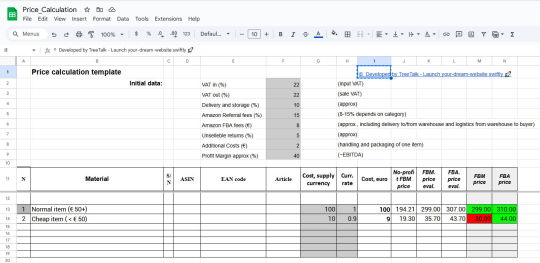
In the gray fields, enter the initial data: purchase VAT (if the product is imported, it may differ from the retail price), sales VAT (if required for the country of sale), approximate percentage of shipping and storage costs (from the purchase price), Amazon Referral fees, Amazon FBA fees for one average unit (must include delivery to warehouse and logistics from warehouse to buyer), percentage of returns unsuitable for further sale, costs of processing and packaging the product, and the desired Profit Margin.
A couple of comments. Usually, the issue of customer returns is delicately omitted by various online coaches, but it will give you a lot of headaches. While customer-friendly, the overly lenient Amazon return policy often leaves sellers at a disadvantage, with a high return percentage eating into profits

Statistics show gigantic (and growing) volumes of returns, the percentage of which fluctuates from 5 to 40, depending on the category. Most returned goods are unsuitable for further resale - just look at this sample returned from Amazon.

One of the ways to automatically check buyers for reliability and propensity for returns and fraud is TreeTalk Credenza. This useful tool helps to store order data in a GDPR/CCPA-compliant manner and checks buyer ratings in a semi-automated mode using both local and crowdsourced databases.
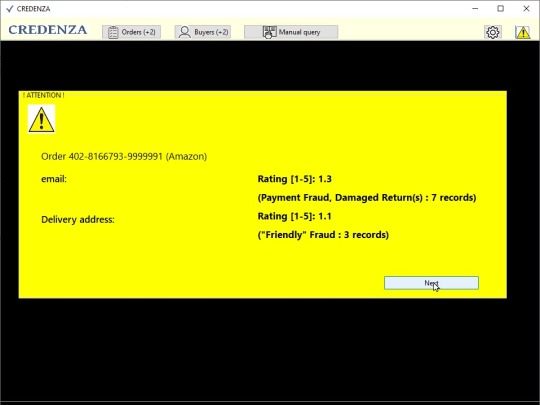
If you already use this software, the refund rate may be reduced, but we still have to consider it, because a return is not just a loss of revenue on the product, it is also a loss in storage and delivery back and forth from the buyer, and with the FBA scheme - also to the Amazon warehouse and back to you. Therefore, we must take this into account.
As for the Profit Margin, it may seem big to some, but later you will understand why you should not set it too modestly.
In the table itself, we enter the purchase price and, if necessary, the exchange rate if the purchase currency differs from the sale currency.
White fields will be calculated automatically based on the entered data. The "No-profit FBM price" column calculates the minimum price for selling without profit using the FBM scheme (Fulfillment by Merchant, i.e. with your logistics), the "FBM price" column calculates the acceptable price for selling using the FBM scheme, and the "FBA price" column calculates the acceptable price for selling using the FBA scheme (Fulfillment by Amazon, that is from a warehouse and with Amazon logistics).
Here are the first results. We see that a product purchased at a price of $50 or more should be sold at three times the price, and a cheap product at least four times the price.

The calculation formulas for expensive and cheap products have different empirical coefficients. When calculating for your product, just copy the corresponding line.
Now we have a minimum price. However, reality may make adjustments. Study BuyBox and competitors' offers. If their prices are higher - great, enter your final price in the last two columns and mark it green. However, the price of competitors or Amazon itself for the same or similar product may be lower than the calculated one. If the product has already been purchased, you will be forced to lower the price. It's good if it still allows you to make money...
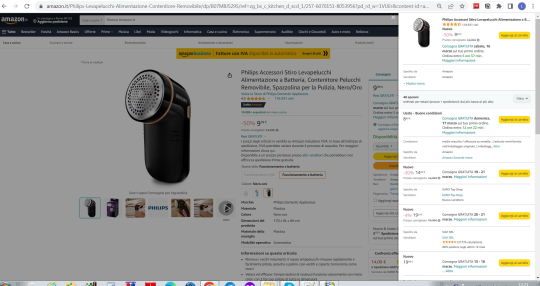
Amazon's own competition in the BuyBox can be particularly disheartening, as the platform often prioritizes its products or those of larger sellers, making it difficult for smaller businesses to get a fair share of visibility.
Dividing the pie. Who gets the lion's profit share?
To check the business model, we have two Reverse check tabs. We transfer the values from the first table or adjusted figures to the "Initial data" section. In the gray Price field, we indicate the real selling price. And we get Unit Economics for your product in real money.
So, when selling a product on Amazon, bought for 100 euros, for 310 euros, you will receive about 38 euros of them (roughly 12%). Is there an error here? No, everything is correct - the control figure of 37.8% shows a marginality close to the specified one. What's the trick? It should be taken into account that you indicated the desired marginality from the purchase price (100 euros), and Amazon and the state take their commissions from the selling price (310 euros). As a result, Amazon is the main beneficiary of your activity, having 70 euros or more than 22 percent of the pie. The state is not far behind, having 22 percent in the form of VAT (you will pay other taxes from your share later).
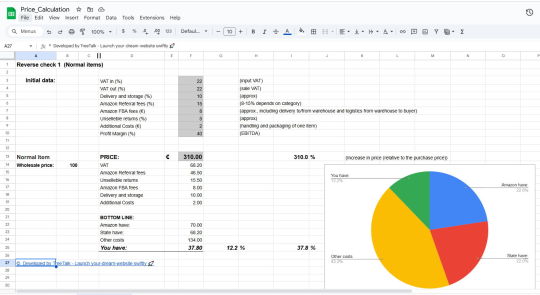
There's nothing we can do about government bureaucracy at the moment. Still, a reasonable question is: what if, instead of giving Amazon the lion's share of the revenue, we sell the goods in our own online store, for example?
Just memorize this idea. We will return to this later, but for now - the second tab Reverse check.
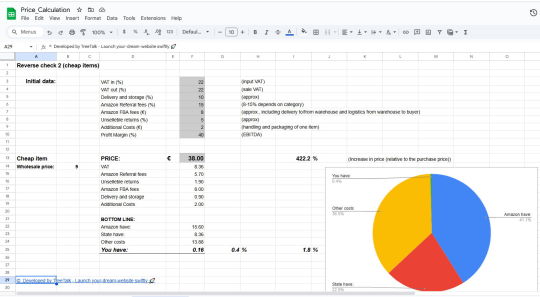
It contains the calculation of Unit Economics for a cheaper product.
Let's see, to make a profit we sell the product almost 5 times more expensive than the purchase price, for 44 euros. Of this, you will receive less than 4 euros (about 8 percent). Conversely, Amazon has more on the cheap product - 38 percent.
But what if competition forces you to lower the price? Let's see. Trouble! At a price of 40 euros per unit, your share of the pie will decrease dramatically, to 3 percent. And at a price of 38 euros, your revenue will fall to zero. At the same time, the state will still get its swag, and Amazon's share will even increase, wow!
Like our spreadsheet? You can buy it right now by paying securely with Stripe here. Or you can get it for free by subscribing to our partners' news - TreeTalk Credenza.
But let's continue. Okay, let's put the price back in place, so the math is not so scary. But if you think that since you are in profit, you can live happily on your couple of bucks, I have to disappoint you...
Navigating Amazon's "Innovations" and Pitfalls: Wierd Cash Flow
In the "Payments" section on Amazon, you will find beautiful graphs. Let's take a look and figure it out. This is a chart from a real test account.
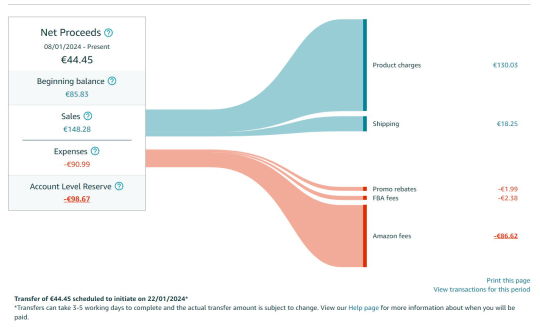
First of all, pay attention to the payment date. Amazon pays money to your account twice a month. So, you will not receive the money immediately, as if it were your own store. Plan your churn rate taking this into account! And you, as we have already figured out, will only receive part of the money. Amazon will keep a little less than half. But remember - you must pay VAT from the Net volume from sales (that is, from your share and from Amazon's share). By the way, what are these "Promo rebates"? Yes, get used to it: Amazon will pay for promotions and benefits for premium customers out of your pocket.
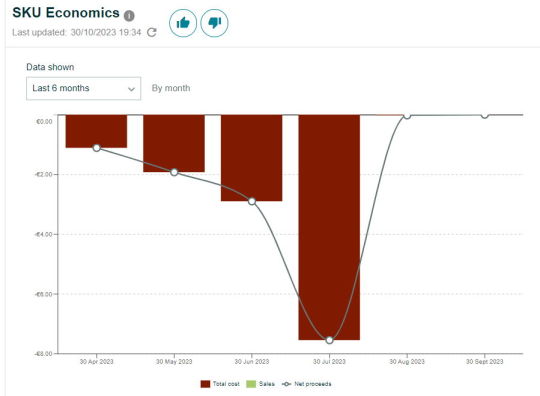
Let's look at another interesting graph from the Amazon admin panel. It shows what happens if you send a product to an Amazon warehouse but it doesn't sell. The cost of storage and maintenance increases every month. So don't forget to recall such products from the warehouse.
Well, let's imagine that you have succeeded and your sales are growing. Let's look at another chart.
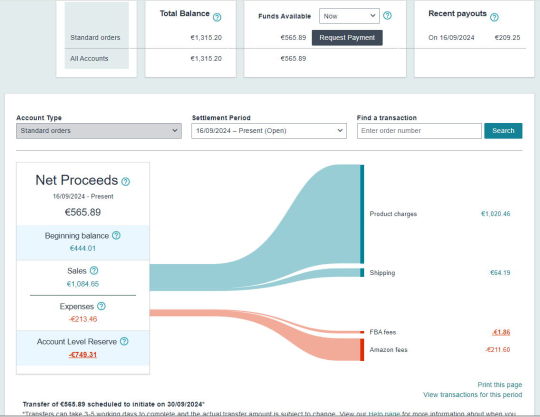
We optimized prices and refused Amazon's warehouse and logistics services, and it seems like Amazon's share has decreased. But why, with sales of 1084 and a balance of 1315, will we only get 565 in the next payment (in 2 weeks again)? Note the interesting figure - 749 in the Account Level Reserve. This is the money that Amazon will keep as insurance against returns. The more sales, the greater the reserve. It can only be received by you with zero sales. That is never?
Navigating Amazon's "Innovations" and Pitfalls ... and lots of small bumps
Global Trade Item Number (GTIN) and barcodes for Amazon
To sell a product on Amazon, it must have a GTIN - Global Trade Item Number (EAN or UPS barcode). You can find what is it in the wiki, but for now, it is important to remember three things.
If the manufacturer of the product has already assigned it a GTIN, this is good, but it means that many sellers can sell it.
If the product does not have a GTIN (like many Chinese items), you will have to register and get your own numbers. In most countries, this is a paid service and involves a subscription. GTINs are also resold, but buying a dozen (or a hundred) of other people's numbers is a bad idea; Amazon will sooner or later discover that they do not correspond to the product, and the item will be blocked.
Before creating a product card, always verify the GTIN using the official service to avoid delays or blocking.
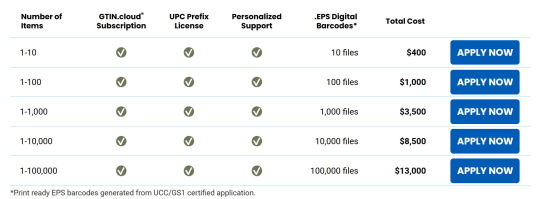
Tricks with BuyBox Amazon: How do you win?
It's great if the product sells well. But be careful: in this case, Amazon can invite the manufacturer, or start selling it itself. In this case, your competitive chances are small. Look, our price is lower, and the leader of the BuyBox is still who do you think?
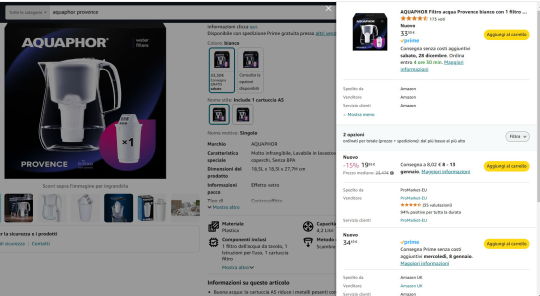
European regulations: additional bureaucracy issues
Want to sell your product on Amazon to European countries? Make sure your account meets:
DAC7 : European tax number and other details required;
European address and representative required for returns and customer service;
Electrical product certification required (in some countries);
Contract and registration numbers required for packaging disposal;
New requirements are coming in regularly.
Missed something? Get an unpleasant notification:

Didn't miss anything and took everything into account? This is also not a guarantee against problems. Let's move on to the frightening part.
The risk of suspension / blocking listings and the Amazon account as a whole. Account health.
Take a look. We received such a notification last year. And when? On the eve of Black Friday! We discovered that our account and all listings were blocked, and Amazon offered to take the goods from warehouses or they destroy them!
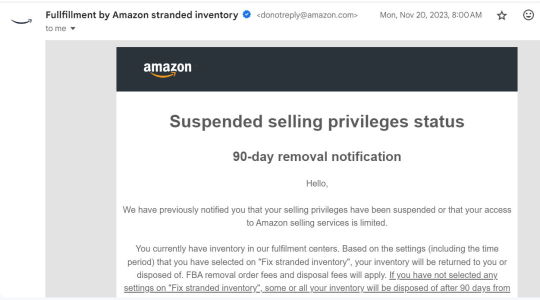
What was that? Look at the response from Amazon support:
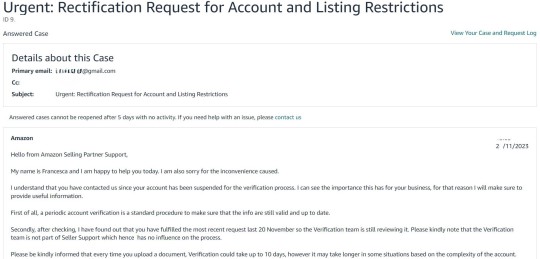
"a periodic account verification is a standard procedure, which can take 10 days or more"
In the end, our account and listings were unblocked, but we missed a week of shopping and sales. And we were lucky, I think! Just google the chilling cases of Amazon account blocking with millions of dollars stuck in limbo!
In general, an account can be suspended or blocked for many reasons and "policy violations" that you may not even be aware of. So visit the Account Health section of your Amazon dashboard often.
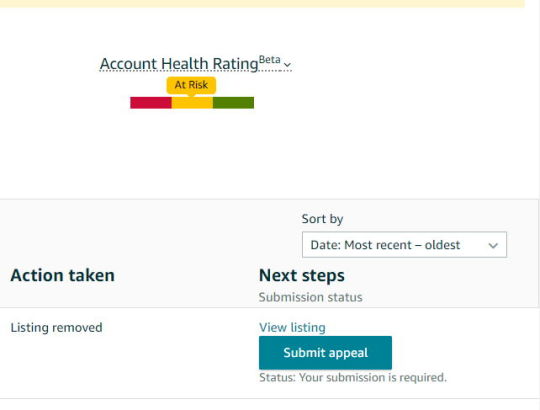
Messages from Amazon: how to deal with dozens of them?
After the scary chapter about account blocking, let's relax a bit and see what messages come from Amazon, say, during the week.
Take action: One or more of your offers are not eligible to be a Featured Offer (Buy Box)
The most frequent message, speaks for itself.
Your payment is on the way: Disbursement Attempted
Great news! But why "attempted"? What can go wrong? A lot! Firstly, Amazon sends money not to all accounts, but only to accounts in trusted banks, the list of which is constantly changing. Secondly, before each money transfer by account details (IBAN), Amazon checks whether it can rip off money from your linked Amazon credit card, which must also be verified. Periodically, on one or another national Amazon, the account or card may be "unlinked", respectively, disbursement does not pass, and you need to verify another card.
Commande à expédier et chargement de facture
This is a good message - there is a new order to be sent. Why in French? Each national Amazon sends mail in its own language...
Action required: Provide GPSR compliance information
This is a 2024 innovation, a "surprise" from the European Commission. Now it is necessary to:
• Appoint an EU-established Responsible Person; • Display the contact information for the manufacturer on your listings and labels (in other words, disclose it to competitors and Amazon itself); • Provide "Warning and safety information".
Usually, when we receive a message like "Action required" from Amazon, we prefer, instead of spending time on fulfilling Amazon's requirements, to invest this time in improving our own website and promoting products on it - and it pays off!
But, in this case, there is a real threat of deactivation of listings and impact on "Account Health", so this message should be taken seriously and time should be spent on studying and fulfilling the new requirements.
On average, Amazon sends 40-50 emails a week, some of which require urgent attention. So the next very popular question seems to already have an answer:
Is Amazon FBA passive income?
Of course not! If you receive fifty emails a week that require a response, then this is more like full-time employment! And if you remember that Amazon itself receives the maximum revenue from your sales on Amazon, then in fact this is true - by selling goods on Amazon, you work for Amazon.
If you don't like this kind of thing, we can help. We know that dealing with Amazon's requirements takes time and effort. That's why we offer Amazon account administration, Amazon account management, running an Amazon store and creating product listings (use discount code YourStore202403).
But what's far worse is that your business is completely dependent on the marketplace, which can change the rules at will at any time.
Is there an alternative to Amazon for selling physical goods?
Yes, several alternatives offer you varying degrees of freedom and control. Here are some options, listed in order of increasing freedom: 1. Other Marketplaces, like eBay, Etsy or Walmart Marketplace are user-friendly, but you still have limited control over the branding, pricing and customer experience. 2. Platforms Offering Modular Constructions, like Shopify or BigCommerce allow you to create a customized online store, giving you more control over the design and functionality of your store. However, they still come with monthly fees, transaction costs and limited customization options. 3. Your Own Online Store on Own Hosting gives you maximum freedom.
Building your own online store on a self-hosted platform like WordPress with WooCommerce or Magento, you have complete control over the design, functionality, cash flow and customer experience. Yes, it requires more initial efforts, which, however, pays off quickly.
Don't know where to start? Contact the experts. TreeTalk will help you create and launch your independent online store or modern landing for your product in 1-2 weeks. And with a discount code (YourStore202403), it will be even cheaper.
There's no need to limit yourself to just one sales channel. If you think you've got the strength to handle several sales channels at once, you can do it. Using the right tools can make your task a lot easier. For instance, TreeTalk Credenza software will gather your imported orders from marketplaces and your own store into one local database, in line with GDPR, and will also automatically check the buyer rating. The check is done not only on your company's internal database, but also on the depersonalized crowdsourced database. This way, you can probably cut down on the risks from unscrupulous buyers and reduce the percentage of returns.
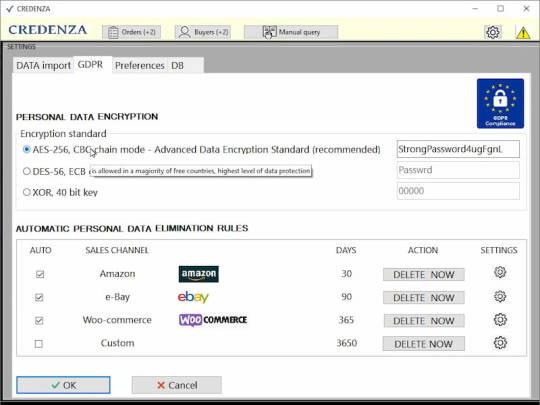
Conclusion. Selling n Amazon for profit? It's possible, but not easy.
This article is just a brief overview, so we didn't get into all the nitty-gritty details. We still didn't cover many important things, such as the ins and outs of the A-Z warranty claims, how to handle returns and losses in the Amazon Fulfilment Centers, what to do with damaged goods, or how to negotiate contracts for packaging disposal in different countries.
Subscribe to our YouTube channel-1 and channel-2 now to stay up to date with our latest video reviews and ask your questions in the comments. We will do our best to answer everything.
If you find this article interesting and informative, share it with your colleagues. Thank you for reading and we wish you success in your commerce!
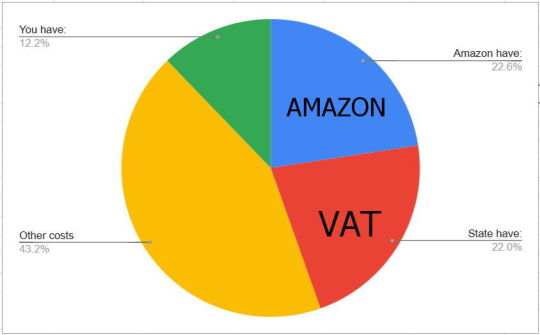
Optimal product pricing on Amazon
1 note
·
View note
Text
Mastering Amazon Seller Flex: The Secret to Faster Shipping and Satisfied Customers

Shipping speed is no longer just a competitive advantage in e-commerce; it’s a necessity. In the race to win the Amazon Buy Box and satisfy customers, Amazon Seller Flex emerges as a game-changer for sellers. This advanced fulfillment program combines the benefits of Amazon’s Fulfillment by Amazon (FBA) model with the flexibility of managing operations from your warehouse. Here's everything you need to know about Seller Flex in 2024, including its latest updates and advanced strategies.
What is Amazon Seller Flex?
Amazon Seller Flex is a program designed to help sellers use their own warehouses to fulfill orders while still benefiting from Amazon’s logistics network. It enables:
Prime Badge Access: Sellers using Seller Flex can qualify for the Prime badge, boosting visibility and trust.
Shipping Speed Optimization: By leveraging Amazon’s carrier contracts, shipping is faster and more affordable.
Inventory Control: Sellers retain more control over their inventory compared to FBA.
Benefits of Amazon Seller Flex
Cost EfficiencyWith rising fulfillment fees, Seller Flex allows you to save costs by managing inventory at your warehouse and shipping directly to customers.
Enhanced Customer ExperienceFaster delivery times and accurate tracking systems ensure higher customer satisfaction, leading to better reviews and repeat purchases.
ScalabilityUse your existing warehouse infrastructure, saving you from investing heavily in third-party logistics.
Regional Fulfillment AdvantageFulfill orders faster by strategically placing warehouses closer to key customer hubs.
Improved Buy Box Win RatesFaster shipping and Prime eligibility significantly enhance your chances of securing the coveted Buy Box.
How to Get Started with Amazon Seller Flex
Eligibility CheckReach out to Amazon to confirm your eligibility. Seller Flex is often extended as an invite-only program for high-performing sellers.
Warehouse SetupEquip your warehouse with proper infrastructure to meet Amazon’s operational standards.
Integration with Amazon SystemsWork with Amazon to integrate your inventory and shipping data seamlessly.
Optimize Shipping StrategiesUse Amazon’s carrier partners to ensure timely and cost-effective deliveries.
Track KPIs RegularlyMonitor metrics like Delivery Time, Order Defect Rate, and Customer Satisfaction to maintain performance.
Advanced Tips for Seller Flex Success
Leverage Data Analytics: Use tools like Seller Central Reports to analyze sales trends and optimize inventory placement.
Invest in Automation: Automate your warehouse operations to speed up order fulfillment and reduce errors.
Optimize Packaging: Minimize packaging time and costs while adhering to Amazon’s guidelines.
Provide Real-Time Tracking: Enhance transparency by offering customers live tracking updates.
Offer Multi-Channel Fulfillment: Use Seller Flex to fulfill orders from other platforms like Shopify or eBay.
Trends Impacting Seller Flex
Sustainability: Amazon is pushing for eco-friendly shipping practices. Optimize your packaging and delivery routes to align with this trend.
AI in Fulfillment: Advanced AI tools help predict demand and manage inventory efficiently.
Regional Warehousing: Expanding fulfillment centers in local regions can further improve shipping speed.
Conclusion
Amazon Seller Flex is the ultimate tool for sellers who want the best of both worlds: the trust and reach of Amazon Prime and the flexibility of running their own operations. By mastering Seller Flex, you can not only enhance your shipping speed but also build a more profitable and sustainable business.
0 notes
Text

Amazon Multi-Channel Fulfilment is a cloud-based tool that helps sellers fulfill their orders across multiple e-commerce marketplaces such as Shopify, WooCommerce, and TikTok Shop, synchronizing product listings, inventory, and order fulfillment flawlessly. A more complete and adaptable option for companies looking to improve their order fulfillment process is offered by Amazon MCF by WebBee for TikTok Shop.
#ecommerceintegration#webbeeglobal#amazonmcfbywebbee#tiktokshop#AMZ TikTok#TikTokAmazonIntegration#orderfulfillment#product listing services
0 notes
Text
The Future of e-Commerce: How API Integration is Revolutionizing Online Retail
The e-commerce landscape is evolving rapidly, and businesses must adopt advanced technology to stay ahead. One of the most impactful innovations in recent years is e-Commerce API integration. APIs (Application Programming Interfaces) allow seamless communication between different platforms, enabling businesses to automate operations, enhance customer experiences, and scale efficiently. As a result, leading e-Commerce solutions companies are increasingly focusing on API-driven solutions to help businesses streamline their workflows.
Why API Integration is Essential for e-Commerce Growth
E-commerce businesses rely on multiple tools to manage their operations—payment gateways, order fulfillment systems, inventory tracking, and marketing automation platforms. Without integration, managing these processes can become chaotic and inefficient. This is where e-Commerce API integration comes in, offering a seamless way to connect various platforms and eliminate manual work.
One of the most critical applications of API integration is product management API, which helps businesses keep their product catalogs up to date across multiple sales channels. This ensures customers always see accurate stock levels, product descriptions, and pricing, improving the overall shopping experience.
Key Benefits of e-Commerce API Integration
1. Faster and More Accurate Product Updates
A product management API allows businesses to instantly update product information across websites, marketplaces, and social media platforms. Instead of manually adjusting prices or descriptions on each platform, API integration ensures all updates are synchronized in real-time.
2. Automated Order Processing and Fulfillment
Customers expect fast and reliable order fulfillment. API integration connects e-commerce stores directly with warehouses and shipping partners, ensuring that once an order is placed, it is processed automatically. This reduces human errors, minimizes delays, and improves efficiency.
3. Improved Customer Experience
Consumers today demand real-time updates on their orders. e-Commerce API integration enables automated tracking updates, personalized recommendations, and smooth returns, leading to higher customer satisfaction and loyalty.
4. Seamless Multi-Platform Selling
Selling on multiple platforms like Amazon, Shopify, and eBay can be complex. A product management API allows businesses to maintain consistent product listings, stock availability, and pricing across all channels without extra manual effort.
5. Better Decision-Making with Data Insights
APIs enable businesses to gather real-time data from different sources, providing valuable insights into sales performance, customer behavior, and inventory trends. This data helps in making informed decisions, optimizing marketing strategies, and improving overall business performance.
How e-Commerce Solutions Companies Help Businesses Scale
While API integration is powerful, implementing it effectively requires technical expertise. Leading e-Commerce solutions companies offer custom API integration services tailored to specific business needs. These companies provide:
Custom API development: Creating tailored solutions for unique business requirements.
Integration with third-party tools: Connecting e-commerce platforms with CRM, ERP, and analytics systems.
Ongoing support and optimization: Ensuring APIs function smoothly as business needs evolve.
Conclusion
The future of e-commerce lies in seamless automation, and e-Commerce API integration is the key to unlocking efficiency and growth. With the right product management API, businesses can manage inventory effortlessly, enhance customer satisfaction, and scale across multiple channels. By partnering with experienced e-Commerce solutions companies, brands can harness the power of APIs to streamline their operations and drive long-term success.
0 notes
Text
How Amazon Order Management Software Simplifies Multi-Channel Selling
Managing orders across several platforms presents both opportunities and challenges in the e-commerce industry, particularly given Amazon's wide reach. Amazon Order Management Software (OMS) makes multi-channel selling easier for companies trying to optimize their operations. Here is a thorough examination of the benefits that Amazon OMS offers multi-channel merchants and why it is a vital tool for any company looking to grow in the cutthroat market of today.
1. Centralized Order Processing
The capacity of Amazon OMS to consolidate orders from many channels, such as Amazon, other online marketplaces, and even in-store transactions, is a major advantage. This characteristic:
Eliminates the need to log into several systems by combining orders into a single, complete dashboard.
Automatically updates order statuses across channels in real-time, reducing human error and manual tracking.
Simplifies the user interface, enabling companies to track sales results across many platforms without having to move between apps.
By giving sellers greater insight into their business, centralized order processing boosts overall efficiency and can help in the early detection of fulfillment process problems.
2. Automated Inventory Syncing
It might be difficult to manage inventory across several channels, however companies can maintain inventory synchronization with Amazon OMS:
Stock levels mirror sales across all channels thanks to real-time updates that guarantee precise inventory tracking.
Automatically modifies inventory following each transaction, lowering the chance of overselling.
Enables bulk inventory management and uploads, which is very helpful for companies with huge product catalogs.
Businesses using multi-channel selling methods must have inventory synchronization since it prevents backorders, increases customer happiness, and lessens the need for frequent human changes.
3. Enhanced Fulfillment Management
The core of any online business is order fulfillment. Amazon OMS facilitates the fulfillment process by providing:
Integration with various fulfillment centers and Amazon FBA (Fulfilled by Amazon) enables companies to select the best shipping and delivery choices.
Orders are automatically routed to the nearest warehouse or fulfillment facility, cutting down on delivery times and shipping expenses.
Returns are processed quickly and effectively, simplifying the procedure for customers to return products when needed and improving the entire purchasing experience.
Long-term success in e-commerce depends on a strong fulfillment process since it increases sales and fosters consumer loyalty.
4. Managing Customer Interactions and Returns
A smooth shopping experience depends on efficiently managing several client interactions. Using Amazon OMS:
Customers are kept updated and fewer customer care requests are made by means of automatic communication about the progress of their orders.
Customers can track the progress of their orders from dispatch to delivery with the use of comprehensive tracking and alerts.
Makes it simple to manage returns and guarantees that consumers who decide to return items have a positive experience.
This component of OMS increases brand trust and customer happiness, which promotes repeat business and favorable word-of-mouth referrals.
0 notes
Text
Maximize Your E-Commerce Potential: Key Benefits of Choosing a Marketplace Management Service

In the rapidly evolving e-commerce landscape, choosing the right E-commerce Marketplace Management Service is crucial for businesses looking to scale and optimize their online presence. A well-managed marketplace not only enhances your business's visibility but also streamlines operations, ultimately driving growth and customer satisfaction. At Expand Ecom, we specialize in offering top-tier Marketplace Management Services designed to meet the unique needs of e-commerce businesses, large and small.
Optimized Listings for Maximum Visibility
One of the primary benefits of a Marketplace Management Service is ensuring your product listings are optimized for maximum visibility. With the right keywords, compelling descriptions, and high-quality images, your products stand a higher chance of being discovered in competitive marketplaces. At Expand Ecom, we use data-driven strategies to optimize your listings, ensuring they rank higher in search results and drive higher click-through rates. This leads to more exposure and ultimately more sales.
Efficient Inventory Management
Managing inventory effectively is a core component of any successful e-commerce business. A Marketplace Management Service helps you keep track of stock levels in real-time, automatically syncing inventory across multiple platforms to avoid overselling or stockouts. This integration ensures a smoother process for both you and your customers. Expand Ecom’s inventory management solution not only reduces errors but also minimizes operational costs, keeping your business running efficiently.
Seamless Order Fulfillment
Order fulfillment is a key factor in customer satisfaction. A robust Marketplace Management Service ensures that your orders are processed quickly, accurately, and shipped on time. Through integrations with fulfillment systems, we handle every step of the order process, from receipt to delivery. Expand Ecom’s end-to-end support helps you deliver a seamless shopping experience for your customers, improving customer loyalty and retention.
Enhanced Customer Support
Customer support can make or break your e-commerce business. A professional Marketplace Management Service helps manage customer inquiries, handle complaints, and resolve issues quickly, which contributes to maintaining a positive reputation. Expand Ecom offers integrated customer service tools and dedicated support teams, ensuring a positive experience for your customers, which can lead to higher retention and repeat business.
Scalability and Flexibility
As your business grows, your operational needs will evolve. A Marketplace Management Service offers the flexibility to scale your operations without compromising quality. Whether expanding to new marketplaces or launching additional product lines, Expand Ecom ensures that your business is prepared for growth. Our services are designed to seamlessly scale with your business, ensuring smooth transitions as you expand.
Multi-Channel Management for Broader Reach
Managing multiple online marketplaces can quickly become overwhelming without the right systems in place. A Marketplace Management Service centralizes all your sales channels, allowing you to manage your products and orders on platforms such as Amazon, eBay, Walmart, and Shopify from one dashboard. Expand Ecom’s multi-channel approach ensures that your business can reach a larger audience while simplifying the management process.
Cost-Effective Solutions
Outsourcing marketplace management can actually save you money in the long run. By choosing Expand Ecom’s Marketplace Management Service, you eliminate the need for hiring and training in-house staff, saving on recruitment and operational costs. Our service offers a cost-effective solution that boosts operational efficiency and frees up your resources to focus on other areas of your business.
Ready to optimize your marketplace?
Let Expand Ecom’s Marketplace Management Service help you streamline operations, enhance customer satisfaction, and drive growth. Get in touch with us today to get started!
Why Choose to Expand Ecom for Your Marketplace Management Service?
Expertise: With years of experience in e-commerce, Expand Ecom brings in-depth knowledge to manage all aspects of your online marketplace strategy.
Customization: We understand that every business is unique, which is why we tailor our services to meet your specific needs.
Customer-Centric Approach: At Expand Ecom, customer satisfaction is at the heart of everything we do. We’re committed to enhancing the overall customer experience.
Comprehensive Solutions: From inventory management to order fulfillment, our service covers every aspect of marketplace operations.
By choosing the right Marketplace Management Service, businesses can enhance their operational efficiency, boost customer engagement, and scale without the headaches of manual management. At Expand Ecom, we are committed to delivering exceptional results for your business with our tailored approach. Let us handle the complexities so you can focus on growth and success.
Don’t wait to elevate your e-commerce business! Contact Expand Ecom now and discover the true potential of your online marketplace. Our team is ready to help you grow and succeed!
0 notes
Text
Leveraging Magento Integration Services to Manage Multi-Channel B2B Sales

Managing multiple sales channels is one of the most significant challenges for B2B businesses in the USA. Each platform has unique requirements, from inventory management to customer data synchronization. Without an integrated approach, businesses risk inefficiencies, errors, and missed opportunities. Magento integration services offer a solution that brings all your sales channels together, creating a unified system tailored for enterprise-level eCommerce operations.
In this blog, we’ll explore how Magento multi-channel integration can revolutionize the way B2B companies handle their sales processes.
What Are Multi-Channel Sales in B2B?
Multi-channel sales refer to the practice of selling products or services across multiple platforms, such as eCommerce websites, third-party marketplaces, and direct offline channels. For B2B enterprises, this could mean operating through platforms like Amazon Business, custom eCommerce portals, and vendor management systems simultaneously.
Without proper integration, businesses often face challenges such as:
Duplicated or inaccurate inventory data.
Delayed order processing and fulfillment.
Inconsistent customer experiences across platforms.
This is where Magento custom integration and its suite of tools become essential.
How Magento Integration Services Solve Multi-Channel Challenges
Magento stands out for its flexibility and scalability, especially for B2B enterprises with complex operational needs. With the help of best Magento integration services in the USA, companies can streamline operations and focus on growing their businesses.
1. Centralized Data with Magento ERP and CRM Integration Solutions
Magento ERP integration connects your sales channels with back-office systems like SAP, Oracle, or Microsoft Dynamics. Pairing this with Magento CRM integration tools like Salesforce or HubSpot ensures all customer data, from inquiries to orders, is synchronized for accurate reporting and insights.
2. Enhanced Customer Management with Magento API Integration
Using custom Magento API integration solutions, businesses can develop tailored solutions for managing customers, vendors, and sales channels. This ensures faster data exchange and better control over every sales touchpoint.
3. Simplified Payment Processing
B2B transactions often involve customized payment terms and bulk orders. With seamless Magento payment gateway integration, businesses can support multiple payment methods and currencies, ensuring flexibility for their clients.
4. Efficient Order Fulfillment with Magento Order Management Integration
Magento order management integration automates workflows from order placement to fulfillment. For B2B companies managing bulk orders across multiple channels, this integration reduces processing time and errors.
5. Advanced Product Management with Magento PIM Integration
Magento PIM integration simplifies the management of extensive product catalogs. It ensures consistent product information across sales channels, reducing confusion for customers and sales teams alike.
Benefits of Magento Integration for B2B Businesses
Here’s how Magento integration for B2B businesses drives operational efficiency:
Real-Time Inventory Tracking: With Magento inventory management system integration, businesses can monitor stock levels and avoid overselling.
Scalable Multi-Vendor Management: Magento multi-vendor marketplace integration supports businesses expanding into diverse markets.
Cloud-Based Accessibility: Magento cloud integration services enable businesses to manage operations securely from anywhere.
Third-Party Extensions: Through Magento third-party integration, businesses can enhance functionality without compromising their core processes.
Use Cases: Real-World Success Stories
Magento ERP and CRM Integration Solutions for a Wholesale Distributor
A USA-based wholesale distributor implemented Magento integration with Salesforce to synchronize their customer data and sales pipelines. Combined with Magento ERP integration, the business reduced manual data entry by 40%, improving operational efficiency.
Magento Multi-Vendor Marketplace Integration for an Industrial Supplier
An industrial supplier adopted Magento multi-vendor marketplace integration to manage sales on platforms like Amazon Business and their proprietary eCommerce site. This approach enabled them to double their revenue from online channels within a year.
How to Choose the Right Magento Integration Partner
When searching for the best Magento integration services in the USA, look for:
Expertise in Magento API integration and custom development.
Proven experience in Magento integration for enterprise-level eCommerce.
Capability to handle complex systems like Magento ERP and CRM integration solutions.
Understanding of B2B-specific requirements such as Magento order management integration.
Conclusion
Managing multi-channel sales no longer has to be a logistical nightmare. With the right Magento integration services, B2B businesses in the USA can streamline operations, improve customer experiences, and scale effortlessly. Whether it’s Magento ERP integration, Magento PIM integration, or Magento API integration, these tools ensure every aspect of your business is optimized for success.
Ready to transform your multi-channel operations? Partner with experts offering the best Magento integration services in the USA to unlock the full potential of your business today!
#magento services#magento#magento integration#magento integration services#magento 2#magento development
0 notes
Text
Maximizing eBay Sales with Maropost/Neto and Pursuit Info Solutions

For eBay sellers, success depends on efficient operations, seamless marketplace integration, and the ability to scale. Maropost Commerce Cloud (formerly Neto) offers a robust eCommerce platform designed to empower businesses to achieve just that. Through the partnership between Maropost/Neto and Pursuit Info Solutions, eBay sellers gain access to a complete suite of services that streamline their operations and open doors to new growth opportunities across various online marketplaces.
Why Maropost/Neto?
Maropost Commerce Cloud is an all-in-one eCommerce platform that caters to both B2B and B2C businesses by centralizing essential operations such as inventory management, order processing, and multi-channel sales. For eBay sellers, this platform offers critical features such as real-time stock synchronization, automated order management, and seamless integration with multiple sales channels, including eBay, Amazon, and Catch. The system allows eBay sellers to automate product listings, manage inventory, and process orders, saving significant time and reducing the risk of errors
With its eBay-certified integration, Maropost simplifies marketplace management by synchronizing stock levels and orders across platforms. Once a sale is made on eBay, the order is automatically imported into Maropost’s backend, where it can be processed and fulfilled. Once dispatched, the system updates eBay with tracking and fulfillment information, improving communication with customers and boosting seller ratings
.
The Role of Pursuit Info Solutions
While Maropost/Neto provides the technology, Pursuit Info Solutions offers the expertise to maximize its potential for eBay sellers. Pursuit specializes in setting up and optimizing Maropost platforms, providing eBay sellers with customized solutions tailored to their unique needs. Whether it's setting up a new store, integrating eBay with other channels, or optimizing listings for better visibility, Pursuit delivers end-to-end solutions that help eBay sellers grow their businesses more efficiently.
Key services offered by Pursuit Info Solutions include:
Neto Installation & Design: Pursuit helps sellers create captivating, brand-aligned stores with custom design and user experiences that convert visitors into buyers.
Marketplace Integration: Pursuit ensures that eBay, Amazon, and other marketplaces are seamlessly integrated with Maropost Commerce Cloud. This includes centralizing product, inventory, and order management across all platforms
.
Account Management: For eBay sellers who prefer to focus on growing their businesses rather than dealing with the complexities of marketplace management, Pursuit provides expert account management, handling everything from inventory updates to optimized product listings that increase visibility and sales
.
Advantages of Maropost/Neto for eBay Sellers
Streamlined Operations
One of the standout advantages of Maropost/Neto is its ability to consolidate all eCommerce operations into a single platform. Sellers can manage their entire workflow—from listing products to processing orders and managing customers—without needing separate systems for each marketplace. This not only saves time but also minimizes the risk of errors or delays in updating stock levels or processing orders
Scalability
Maropost Commerce Cloud’s flexibility makes it ideal for businesses looking to scale. Whether you are an eBay seller with a small catalog or a business with thousands of SKUs, Maropost allows you to expand your operations across new markets without increasing operational complexity. Pursuit Info Solutions can help eBay sellers implement advanced functionality, such as adding third-party integrations or building custom solutions to meet evolving business requirements
.
Enhanced Customer Experience
A well-designed eBay store and optimized product listings are crucial for attracting and retaining customers. Pursuit helps sellers create engaging stores with intuitive navigation and captivating visuals that provide an exceptional shopping experience. Coupled with Maropost’s automated order processing and customer updates, this improves overall customer satisfaction and can result in higher eBay seller ratings
.
Conclusion
For Maropost/Neto partners for eBay sellers through Pursuit Info Solutions is an effective way to streamline operations, expand into new sales channels, and ultimately grow their business. By combining Maropost’s powerful eCommerce platform with Pursuit’s tailored services, sellers can focus on scaling their operations while reducing the complexity of managing multi-channel sales. Whether you are just starting out on eBay or looking to take your business to the next level, this partnership offers a reliable, scalable solution to meet your needs.
#amazon listing optimization experts#amazon product listing services#amazon services for sellers#ebay listing optimization experts#maropost/neto partners for ebay sellers#ebay services for sellers#ebay product listing services#ebay sellers services
0 notes